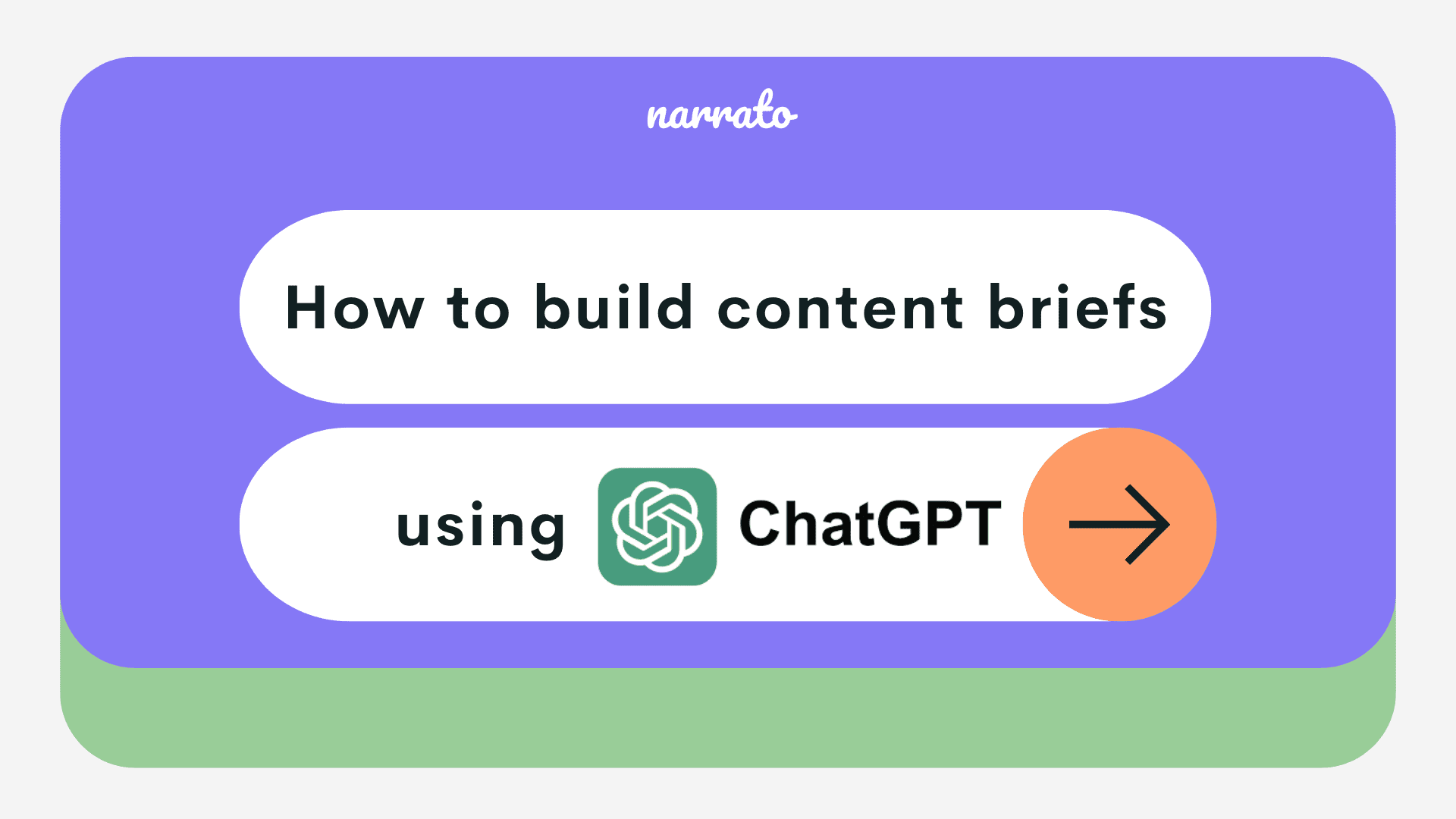If you want to construct a solid physical structure, like a building say, you would most likely follow a detailed blueprint. You would not try to “wing it” or rely solely on your instincts to build something as important as this. The same way, your content marketing team also needs a detailed roadmap to guide them when they’re working on a content project. And that is exactly what a content brief does. It tells your writers what to write, how to write, the objectives to meet, and how to meet them. The content brief provides your writers with direction as well as inspiration. And, if you aren’t sure how to create one, you can use ChatGPT to assist you.
We’ve already explored how to use ChatGPT for content creation, from creating blog content, videos, and emails, to collecting statistics, and more. But ChatGPT can help even when you are using any other AI writer for content creation. In this article, we’ll dive a little deeper into ChatGPT’s content marketing applications, and develop a strategy for using this AI tool to create an effective content brief. In the upcoming sections, we’ll uncover some great tips for building a well-rounded content creation brief, and provide you with some useful ChatGPT prompts to make this process a little easier.
TL;DR here’s a quick video summarizing this article
Building content briefs with ChatGPT
- Generate the title using ChatGPT
- Create a brief overview of the topic using ChatGPT
- Determine the blog content format using ChatGPT
- Find out the target word count using ChatGPT
- Use ChatGPT to define the content goals
- Create audience personas using ChatGPT
- Keyword research for content topic with ChatGPT
- Use ChatGPT to generate topic-specific brand guidelines
- Use ChatGPT to come up with CTA suggestions
- Research reference materials for a topic

What is a content brief?
A content brief, also known as a content marketing brief or content writing brief, is essentially a content outline that serves as a roadmap for content creators. But, don’t confuse it with a general content outline that lists the headings, sub-headings, and the general direction a content piece will take. A content brief provides a more comprehensive overview of all the key elements and objectives of a content piece/project. It lays out the guidelines regarding the content structure, target audience, style, tone of voice, SEO plan, and content goals, among other things. The goal of a content brief is to provide the writers and content creators with all the information they need to create high-quality content.
What to include in a content brief?
There are no hard and fast rules for what should be included in a content brief. A lot depends on your content strategy, the SERP landscape, and your industry. However, there are a few common elements that are found in most content briefs. These include –
- Content topic/theme: To create quality content, writers need to be familiar with the main theme of the content piece. Make sure that you specify the topic or theme you want them to focus on. It’s also a good idea to allow for some wiggle room when it comes to the title, as long as the overarching theme remains the same.
- Target audience: Knowing the target audience helps the writers decide how they want to approach the topic, whether they want to stick to the basics, and go into in-depth detail. The language, tone, and style of writing are also dependent on the target audience.
- Funnel stage: The content brief should also specify the type of content you want, in terms of the funnel stage – TOFU (top of the funnel), MOFU (middle of the funnel), and BOFU (bottom of the funnel). Each type of content represents different points of a buyer’s journey. TOFU content will be more educational in nature, MOFU content will offer possible solutions to buyers’ problems, and BOFU content will aim at converting the customer.
- Content goals: The funnel stage will help the writers understand the content goals, to some degree. However, it is always best to be explicit when it comes to the goals and objectives you want to achieve through the content. Make sure to specify both long-term and short-term goals.
- Synopsis: This will be a summary of points you want the writer to include in the content. You can also add a complete content outline, along with the list of headings and sub-headings.
- Reference material and links: To provide your writers with some inspiration, it’s a good idea to include some article links and other reference material on the same topic. This also provides the writers with an idea about the kind of quality you expect from the content.
- Word count: Specify the minimum number of words you want for the content piece. You can also specify a range, for instance, 1500–2000 words.
- Brand guidelines: Every piece of content should be in line with your brand’s personality and style, so it’s important to specify the brand guidelines in the blog content brief too. Do you want the tone to be casual and friendly or assertive and informative? Do you want the language to be inclusive?
- SEO requirements: Every content brief needs to have some SEO guidelines, whether it is in the specific keywords to target, keyword placement, internal linking, or anything else. If you want the audience to discover your content piece, it has to be sufficiently optimized for online visibility.
- Images/visuals: If you would like to include images, videos, or graphics in your content, make sure to communicate that to your writers through the content creation brief. Give them the specifics about the kind of visuals you want included.
- Call-to-action (CTA) guidance: You can specify what you want the readers to do after they’ve read the article. Even if it is not something specific, a general idea will give the writers the necessary guidance to craft the CTA.
- Deadlines: Every content brief should also include a due date. You can, in fact, add several due dates for different tasks in the content creation process – keyword research, outline, notes, first draft, revisions, and, final submission.
Here is a content brief example –
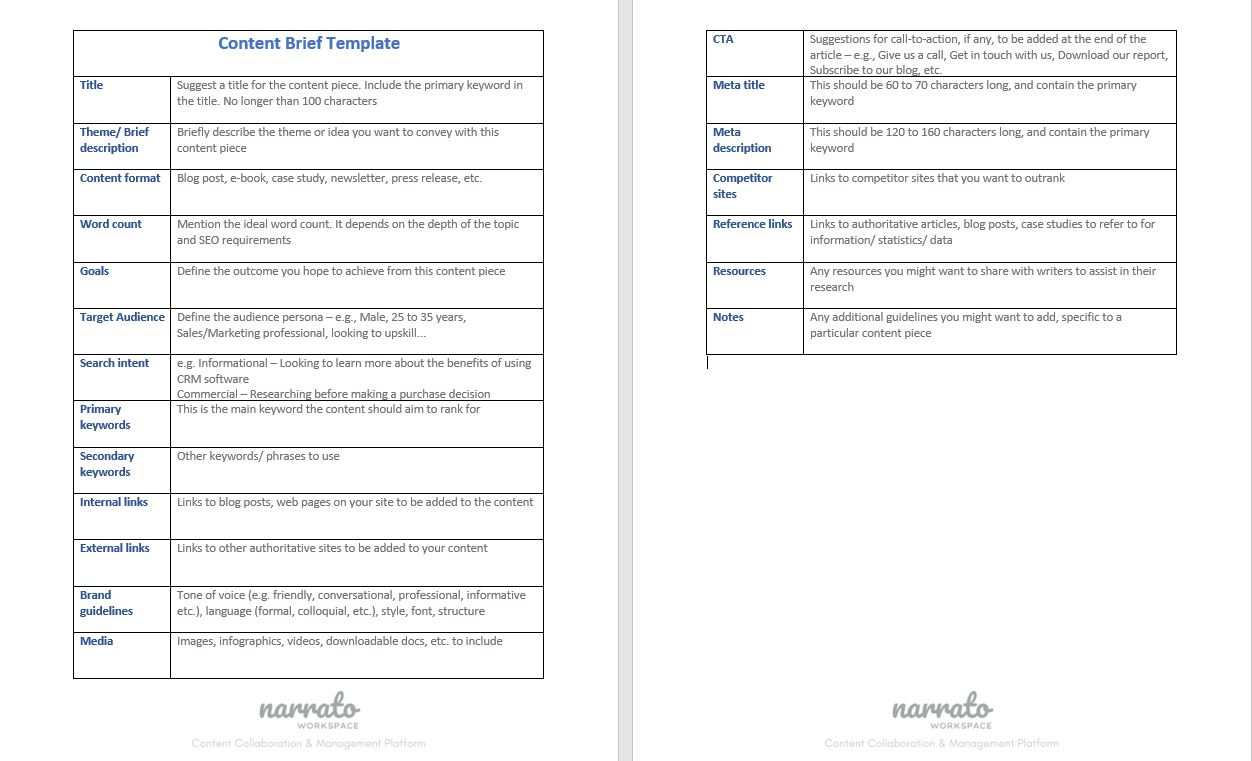
Download this content brief template here.
How can ChatGPT help in building content briefs?
Launched in November 2022, OpenAI ChatGPT has already been making waves in the content industry. This conversational Artificial Intelligence chatbot developed by OpenAI is capable of both understanding and generating text with near-perfect accuracy. It is a natural language processing tool, based on GPT-3 language model, which uses deep learning techniques to engage in human-like conversations. Because of its ability to process large amounts of information in less time, Chat GPT can be an incredibly useful AI tool for content marketing. And it is particularly useful for simplifying time-consuming, research-oriented tasks like creating a content brief.
Here’s how ChatGPT can help you in building content briefs –
- Ideas and suggestions for content brief: ChatGPT can help get the brainstorming process rolling by giving you ideas, perspectives, and key points to add to your content brief format.
- Define content objectives: The content objectives and goals are an important component of a content brief. ChatGPT can help you define (and also refine) your content objectives.
- Content outline: ChatGPT can help you decide the headings, subheadings, and main sections of the content piece.
- Structuring the content piece: ChatGPT can help you organize your thoughts so that your points are laid out logically.
- Keyword optimization suggestions: ChatGPT can help you out with the keyword and SEO guidelines too. It’ll give you ideas for keyword optimization, suggest related terms, and even point out potential variations that’ll boost content SEO.
- Review: After you’ve created a content brief, you can ask ChatGPT to review it and provide suggestions for improvements.
Once we show you how to use ChatGPT prompts for building content briefs in the later sections, you’ll get a better understanding of how it can help during the content brief building process.
What is an SEO content brief?
An SEO content brief goes beyond the general content brief, by incorporating SEO strategies to optimize the content for search engines. While a content brief lays the basic foundation for the content creation process, an SEO content brief outlines the entire SEO plan to ensure greater success. It helps the writer/content creator understand which keywords to target and what strategies will help align a piece of content with the target audience’s search intent.
While ChatGPT can help you come up with general content briefs, it’s a good idea to use a dedicated tool for creating SEO content briefs, since they’re more targeted in nature. The AI content workspace, Narrato, comes with an AI tool that is specifically built for this purpose – the SEO content brief generator. When you input your topic/primary keyword into the AI SEO tool, it generates a comprehensive content brief, that includes keywords, target word/paragraph/heading count, references, and questions to include, among other important SEO parameters. There’s also an SEO score to keep track of content optimization. This SEO score provides a content grade based on a variety of factors, like topical relevance of the content piece, keyword optimization, structure, content length, and readability.
Here is an example of the AI SEO Brief Generator in action. We asked the tool to generate an SEO content brief for the keyword ‘Content Marketing Trends’.

This is the SEO content brief that the tool came up with –

Building content briefs with ChatGPT
By now, you must have a fair idea about all the elements that go into creating a content brief. It’s now time for the fun part – using ChatGPT to build the content brief.
You might think that you could generate a content brief by simply giving a ChatGPT prompt like –
Generate a content brief on the topic ‘Content Marketing Trends for 2023’
Unfortunately, it’s not as easy as that. Giving this ChatGPT prompt would result in an output that looks something like this –

This looks a lot like a basic content outline, don’t you think? When you’re using the artificial intelligence tool ChatGPT, remember that the output will be only as good as your prompt. If you want the tool to generate a good content brief, you need to provide it with more information. A better prompt for creating a content brief would be –
Create a content brief on the topic <Topic>. Include “word count”, “main keyword”, “meta description”, “SEO title suggestion”, “H1 suggestions”, and “instructions for writers”.
When we entered this prompt into Narrato’s ChatGPT tool, this is what it came up with –

You can also take a different approach to build a more comprehensive content brief. Rather than asking it to generate a content brief on a topic, you can use ChatGPT to assist you in building individual elements of the content brief. Then, it’s a matter of refining the brief until you have something that will guide the writers in the right direction and help them create better content.
First, decide everything you want to include in your content brief. You can use the content brief format we provided above, or choose one from the numerous content brief templates you’ll find online, on sites like PandaDoc and Content Harmony.
For the purpose of demonstration, we are using Narrato’s content brief template to build a targeted content brief for the topic ‘Content Marketing Trends for 2023’. We’ll take each individual element of the content brief and use ChatGPT for research.
1. Generate the title using ChatGPT
Let’s start with generating a topic title for the content piece, which can then be added to the content brief.
ChatGPT Prompt: You are a blog topic generator. Generate [X] different creative and catchy titles for the topic [Topic]

The title will provide more context to the writer, allowing them to focus on the article’s intent. This could be a working title, which means that the writer would have the freedom to change the original title to make it more attention-grabbing, as long as the intent remains the same.

2. Create a brief overview of the topic using ChatGPT
Next, you would want to include some basic information about the overarching theme or idea of the topic. This will give the writer ideas on how to approach the topic.
You can write a brief overview (2-3 sentences), explaining what the content should focus on. Or you can simply use ChatGPT to generate this.
ChatGPT Prompt: What should be the general theme of an article on [topic]
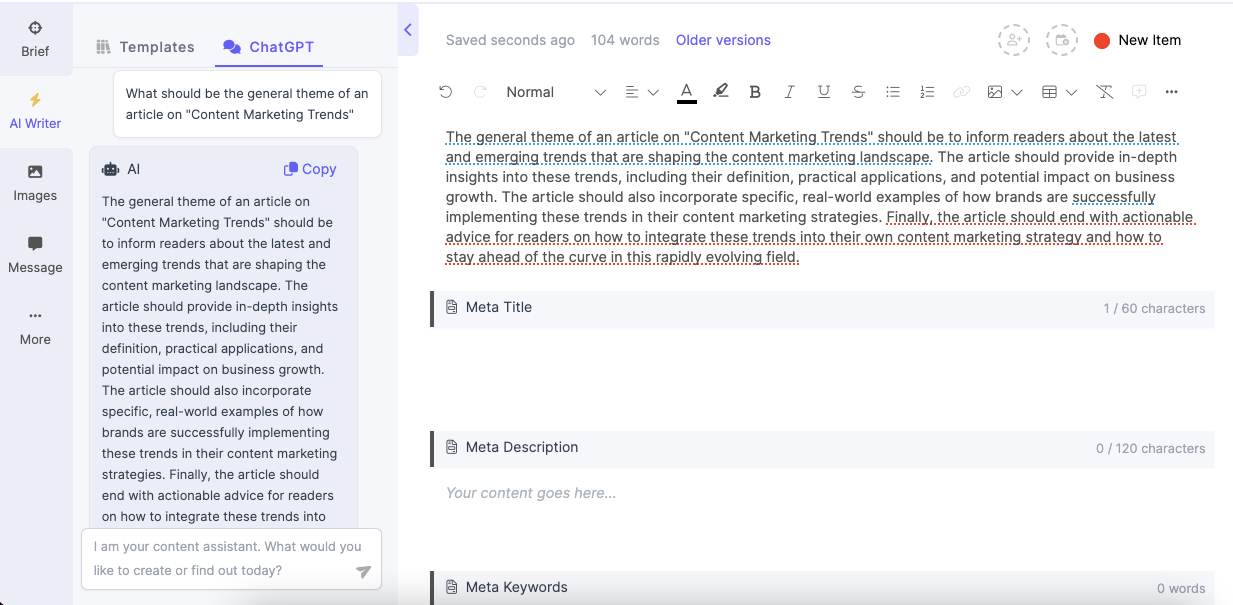
3. Determine the content format using ChatGPT
Specifying the content format is next on the agenda. If you want a newsletter, product description, web copy, e-book, or anything else, this is where you’ll specify the details. But if you want the writer to create a blog, you would first have to determine which blog writing format to use for a particular topic. ChatGPT can help you here. It can provide you with a blog format suggestion that would be best for the given topic.
ChatGPT prompt: What would be the ideal blog content format for the topic [Topic]?
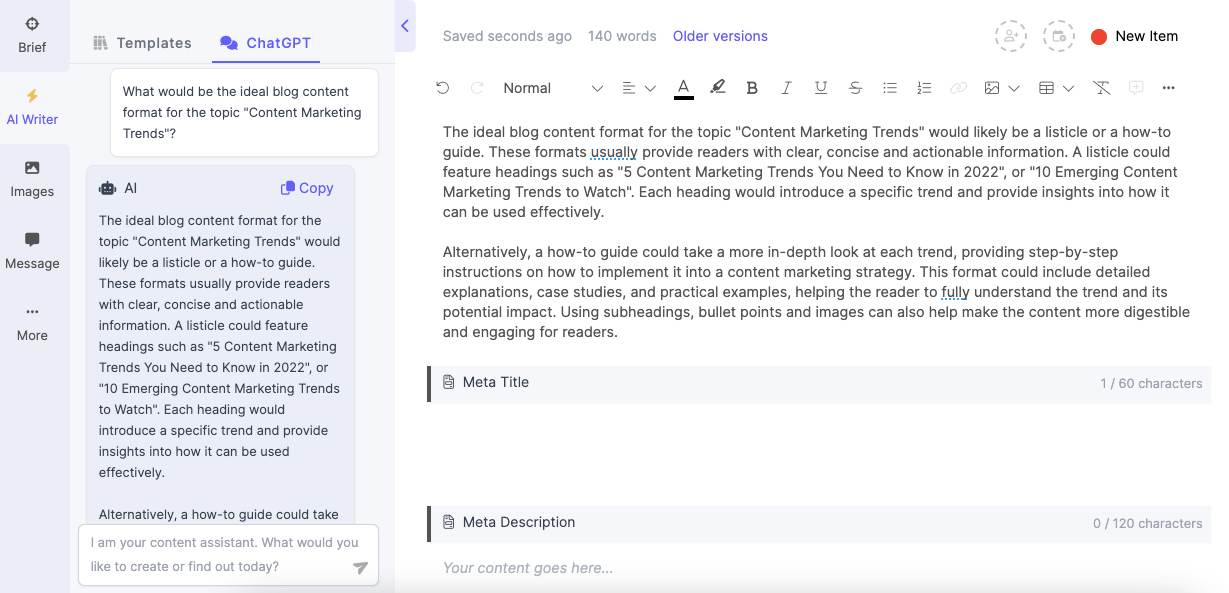
4. Find out the target word count using ChatGPT
Knowing the target word count upfront allows the writer to allocate their time and resources effectively. It helps them plan their writing process, allocate sufficient research time, and set realistic expectations for completing the content within the given timeframe. Adding the target word count to the content brief also provides them with guidance on the depth and breadth of the content.
ChatGPT can help you determine the ideal word count for a topic based on general recommendations and best practices.
ChatGPT Prompt: Suggest an ideal word count for a blog post on the topic [Topic]

5. Use ChatGPT to define the content goals
You need to provide your writers with clear objectives and goals for the content piece so that they know what you hope to achieve from it. Do you want to generate more leads? Do you want to focus on providing value to your target audience? Or, do you want to encourage them to buy something? While most of these content goals will depend on your content marketing strategy, you can use ChatGPT’s assistance to determine a few topic-specific content goals.
ChatGPT Prompt: Define some content goals for the topic [Topic]

6. Create audience personas using ChatGPT
Without crucial information about the target audience, your writers would not be able to create content that resonates with them. To supply this information, you would first have to create an audience persona with details about their demographic data, needs, and preferences. This is where ChatGPT can help. It will not only generate audience personas based on your topic but also define their search intent.
ChatGPT Prompt: Define audience persona for the topic [Topic]. Also, provide information about their search intent

7. Keyword research with ChatGPT
A content brief would be incomplete without the list of target keywords. You need to provide your writers with a primary keyword, and a list of secondary keywords to incorporate into the content, to increase its visibility in the SERPs. Ahrefs Keyword Explorer is a good tool to find a primary keyword for your topic. It provides relevant information about keyword difficulty, search volume, and CPC. And for secondary keywords, you can always use Narrato’s keyword research tool or ChatGPT to research keywords.
ChatGPT Prompt:
- Generate a list of top keywords for [topic] which will improve the content’s search rankings
- Generate a list of long-tail keywords for the topic, [Topic]
- Create a list of LSI keywords for the topic [Topic]. Make sure that it is related to the primary keyword [X]
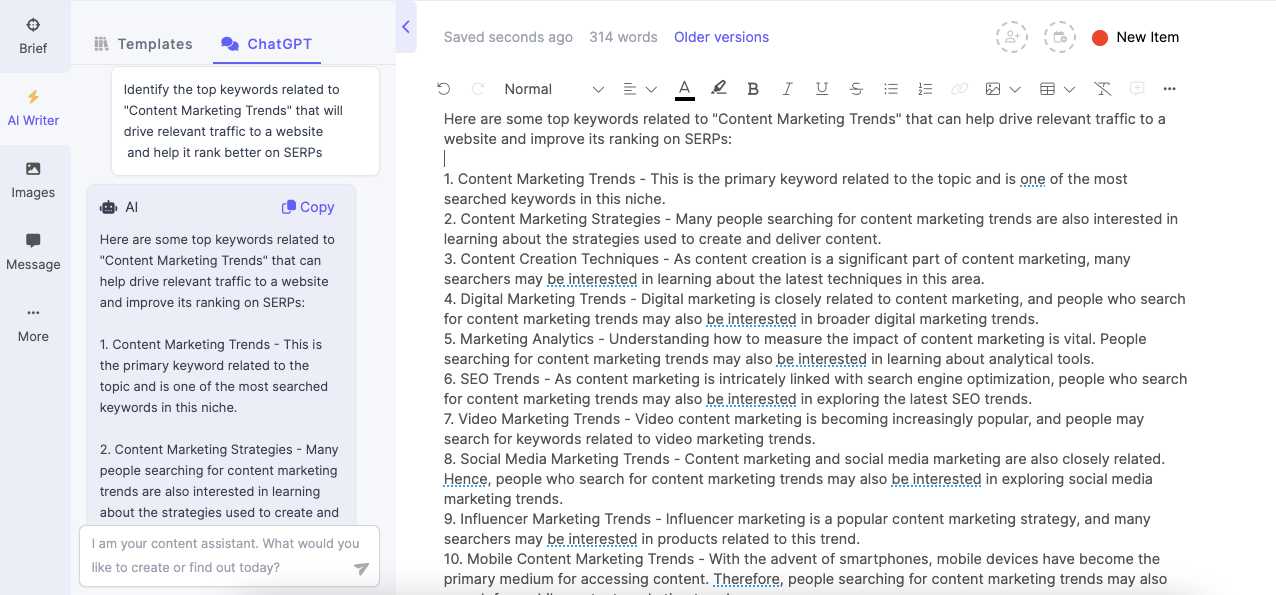
It’s also important to provide your writers with guidelines for incorporating keywords into the content strategically. Specify whether you want the keyword to be added to the title, introduction, conclusion, heading/subheading, alt text, meta description, or anywhere else.
8. Use ChatGPT to generate topic-specific brand guidelines
You might already have some brand guidelines in place, that define the tone of voice, language, style, and other details to craft content that best aligns with your brand image. But, it’s a good idea to include topic-specific brand guidelines in the content brief too. With these topic-specific brand guidelines, the writers will be able to communicate more effectively with the target audience and create content that resonates with them.
ChatGPT Prompt: Generate brand guidelines for the topic “Content marketing trends”

9. Use ChatGPT to come up with CTA suggestions
You would have already mapped out your CTA guidelines while planning your content strategy. When you’re adding these guidelines to the content brief, make sure that you provide your writers with some CTA suggestions too. And ChatGPT can help you come up with them.
ChatGPT Prompt: Generate a list of CTA suggestions for the topic [Topic]
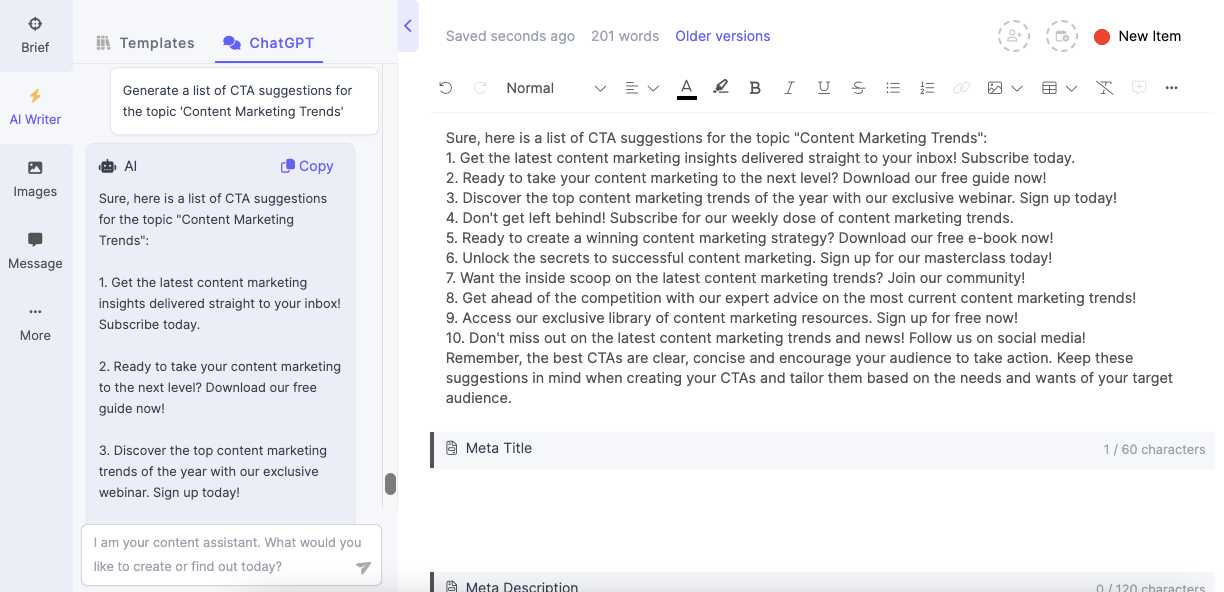
10. Research reference materials for a topic
To guide your writers in the right direction, you can add some reference articles, competitor links, and other materials in the content brief. But, this is not something ChatGPT can help with, because it has only been trained on data up to 2021.
You can use Narrato’s SEO content brief generator to get useful reference links. This AI tool scours the internet for the top-performing content on a topic to provide you with a list of relevant references.

Wrapping Up
This covers everything you know about building content briefs with the help of ChatGPT. With its natural language processing capabilities and vast knowledge base, ChatGPT can prove to be a valuable assistant while building a content brief. By following a structured approach, like the one laid out in this blog post, you can leverage ChatGPT to extract key insights, brainstorm ideas, and gather valuable content suggestions for the content brief. But remember, human judgment and expertise will always be essential in curating a good content brief. So make sure to review the final content brief before giving it to your content team.


